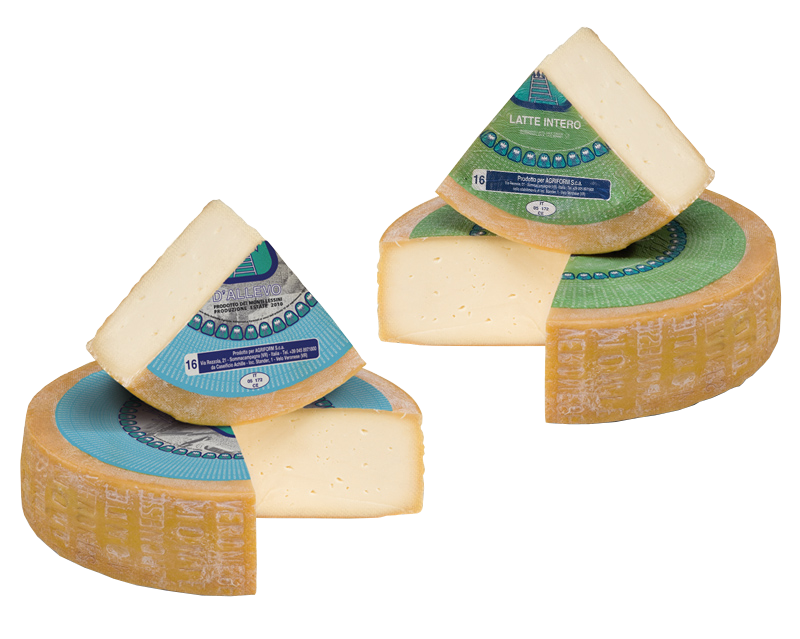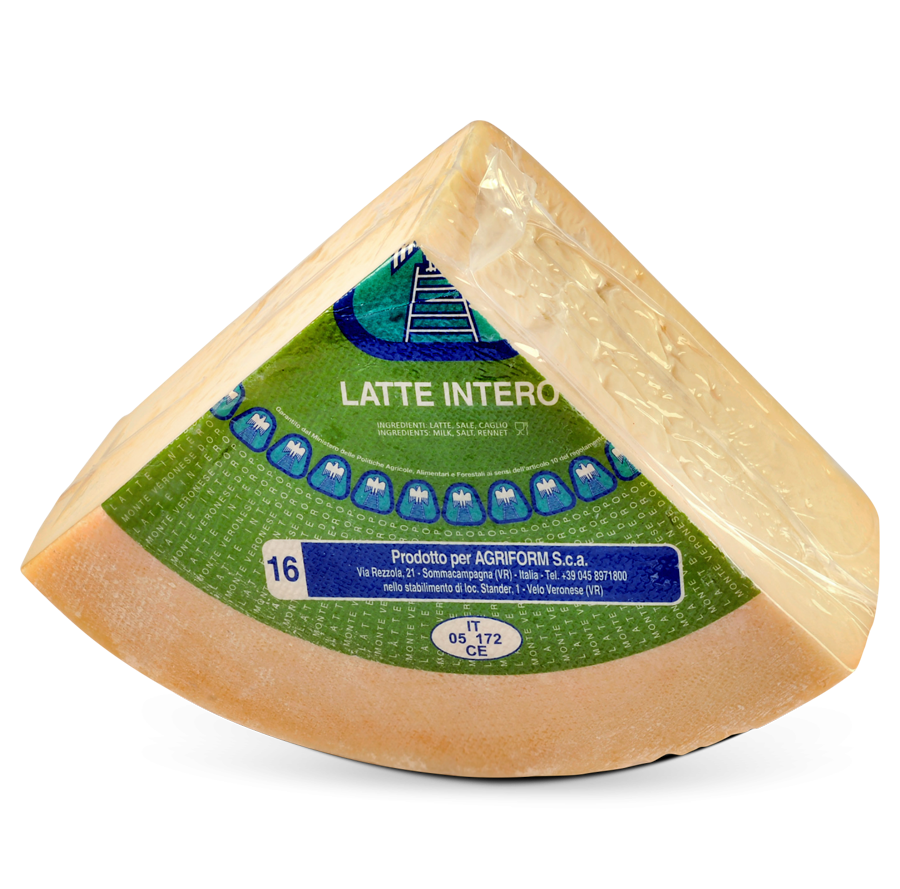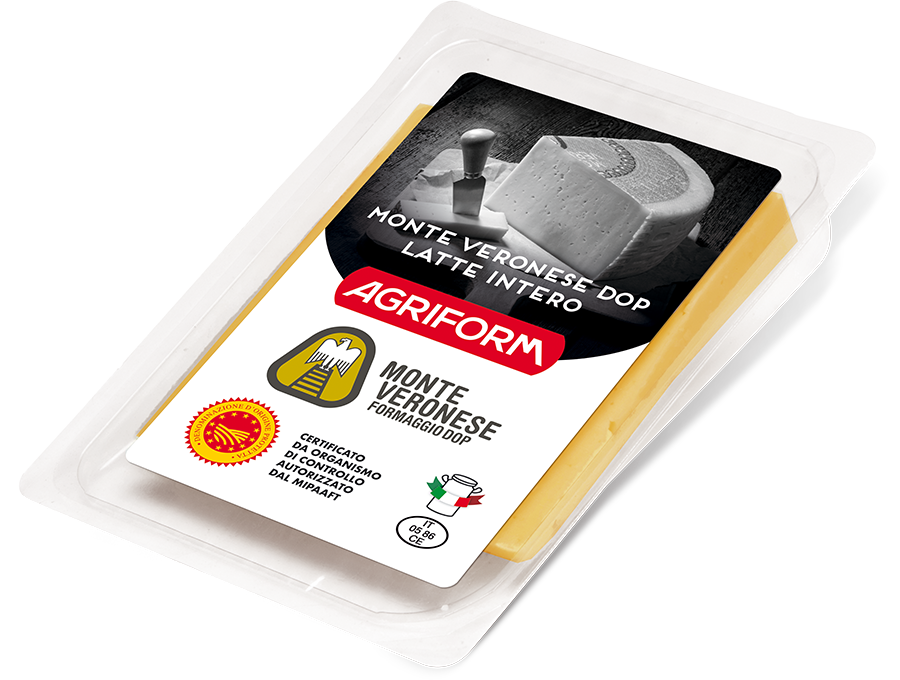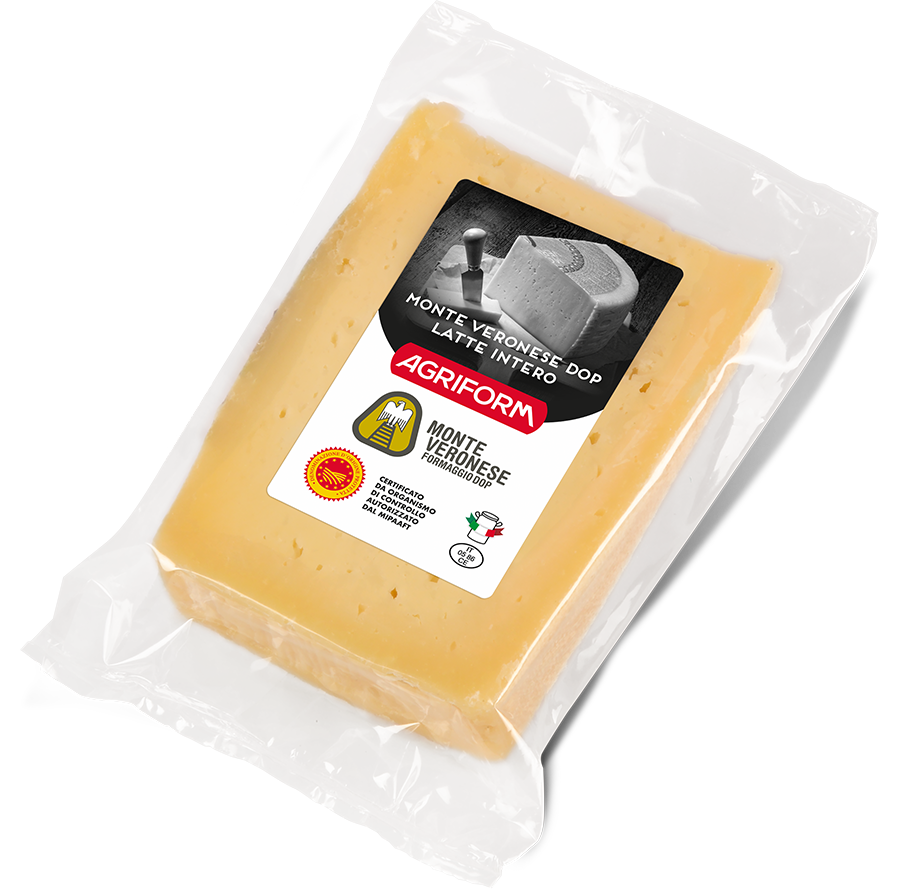
Monte Veronese wheels
Monte veronese whole wheels are perfect for Horeca.
Average weight: approx. 8-9kg
Dimensions: diameter 25/35 cm and height 7/11 cm
Average weight: approx. 8-9kg
Dimensions: diameter 25/35 cm and height 7/11 cm

Vacuum packed Monte Veronese
Vacuum packagings allow the longest durability to Monte Veronese wedges. The total absence of oxygen allows the product to be stored up to 6 months from the packaging date. Available in ¼ wheel wedges for Horeca, and in 250g slices for retail.

Monte Veronese with thermoformed packaging
Thermoformed packagings come in rigid plastic tubs with resealable peel-off film, filled with modified atmosphere and with a 4 month shelf life guaranteed, as well as flexible double-film easy-to-open vacuum packs with a 6 month shelf life.

Monte Veronese in protective atmosphere
Wrapping Monte Veronese under protective atmosphere (food level carbon dioxide and nitrogen) allows to bring to table a cheese slice as if it was just cut. Available in 250g portions.
Monte Veronese PDO
This is a typical table cheese from the mountainous areas located in the northern part of the Verona province. It is a semi-hard, semi-cooked cheese, slightly straw yellow in color with widespread tiny holes and a thin and elastic rind. It is produced in two varieties that vary by the length of their maturation period and by the type of milk used: Monte Veronese Latte Intero has a sweet, delicate taste, while Monte Veronese d'Allevo has a more intense, fragrant taste that becomes sharper as it ages.

Monte Veronese wheels
Monte veronese whole wheels are perfect for Horeca.
Average weight: approx. 8-9kg
Dimensions: diameter 25/35 cm and height 7/11 cm
Average weight: approx. 8-9kg
Dimensions: diameter 25/35 cm and height 7/11 cm

Vacuum packed Monte Veronese
Vacuum packagings allow the longest durability to Monte Veronese wedges. The total absence of oxygen allows the product to be stored up to 6 months from the packaging date. Available in ¼ wheel wedges for Horeca, and in 250g slices for retail.

Monte Veronese with thermoformed packaging
Thermoformed packagings come in rigid plastic tubs with resealable peel-off film, filled with modified atmosphere and with a 4 month shelf life guaranteed, as well as flexible double-film easy-to-open vacuum packs with a 6 month shelf life.

Monte Veronese in protective atmosphere
Wrapping Monte Veronese under protective atmosphere (food level carbon dioxide and nitrogen) allows to bring to table a cheese slice as if it was just cut. Available in 250g portions.
PDO
Protected Denomination of Origin
DETAILS:
• Average weight of the wheel: 8 Kg
• Diameter: 25-35 cm
• Height: 7-11 cm
• Ingredients: milk, salt, bacterial culture, rennet. Rind not edible.
AGEING:
• Young - Latte Intero: from 25 days to 2 months
• Matured: from 2 to 4 months
NUTRITION FACTS (FOR 100G):
Young Monte Veronese
• Energy: 1653 kJ/399 kcal
• Fat: 32,5g
of which satures: 20g
• Carbohydrate: 0,5g
of which sugars: 0,5g
• Protein: 26g
• Salt: 1,95g
Protected Denomination of Origin
DETAILS:
• Average weight of the wheel: 8 Kg
• Diameter: 25-35 cm
• Height: 7-11 cm
• Ingredients: milk, salt, bacterial culture, rennet. Rind not edible.
AGEING:
• Young - Latte Intero: from 25 days to 2 months
• Matured: from 2 to 4 months
NUTRITION FACTS (FOR 100G):
Young Monte Veronese
• Energy: 1653 kJ/399 kcal
• Fat: 32,5g
of which satures: 20g
• Carbohydrate: 0,5g
of which sugars: 0,5g
• Protein: 26g
• Salt: 1,95g
Monte Veronese Fresco is made with whole cow’s milk (raw or pasteurized) from one or two consecutive milkings, enriched with a natural low-acidity starter bacteria. It achieves maturation in approximately 30 days.
The aged variety of Monte Veronese is made using partially skimmed cow’s milk and the cheese is matured for more than two months.
The aged variety of Monte Veronese is made using partially skimmed cow’s milk and the cheese is matured for more than two months.
Monte Veronese has a truly ancient tradition in cheese making.
Historical references indicate that production began in 1200 with the arrival of the Cimbrians, a German population of that came down in search of fertile plains for their livestock; they found the perfect place in the Lessinia mountains, which at that time was a large uninhabited area that local shepherds used for the grazing of their herds of goats and sheep. Thanks to a bishop’s concession, this population was given permission to use all the resources that this land could offered until 1689.
There is also a second theory on the creation of this mountain cheese, which dates back to a more recent period. Documents reported by Varanini in the book “gli alti pascoli dei Lessini Veronesi” (the mountain pastures of Lessini) dating back to the XIII century, refer to a cheese with a strong resemblance but was never identified by the name Monte Veronese. With the fall of the Della Scala family around 1400 and the subsequent difficult economic conditions, there was a great deal of immigration towards the province of Verona; cheeses coming from the Bergamo, Brescia, Valtellina and Milan valleys all meet in this area. According to this theory, it was the Lombardy people who created the foundations for the development of the cow cheese in Lessinia.
Despite its ancient history, the cheese only assumed its final name of “Monte Veronese” at the beginning of the 18th century, with clear and specific reference to the production province. However, don’t let the word “Monte” deceive you: it does not refer to the territory’s mountain ranges, but is a modification of the Italian word monta, which means “mungitura” or milking. In fact, the cheese is made using a technique that involves the curdling of milk from more than one milking.
This product was awarded the PDO (Protected Designation of Origin) status in 1996.
Historical references indicate that production began in 1200 with the arrival of the Cimbrians, a German population of that came down in search of fertile plains for their livestock; they found the perfect place in the Lessinia mountains, which at that time was a large uninhabited area that local shepherds used for the grazing of their herds of goats and sheep. Thanks to a bishop’s concession, this population was given permission to use all the resources that this land could offered until 1689.
There is also a second theory on the creation of this mountain cheese, which dates back to a more recent period. Documents reported by Varanini in the book “gli alti pascoli dei Lessini Veronesi” (the mountain pastures of Lessini) dating back to the XIII century, refer to a cheese with a strong resemblance but was never identified by the name Monte Veronese. With the fall of the Della Scala family around 1400 and the subsequent difficult economic conditions, there was a great deal of immigration towards the province of Verona; cheeses coming from the Bergamo, Brescia, Valtellina and Milan valleys all meet in this area. According to this theory, it was the Lombardy people who created the foundations for the development of the cow cheese in Lessinia.
Despite its ancient history, the cheese only assumed its final name of “Monte Veronese” at the beginning of the 18th century, with clear and specific reference to the production province. However, don’t let the word “Monte” deceive you: it does not refer to the territory’s mountain ranges, but is a modification of the Italian word monta, which means “mungitura” or milking. In fact, the cheese is made using a technique that involves the curdling of milk from more than one milking.
This product was awarded the PDO (Protected Designation of Origin) status in 1996.
Monte Veronese is a mountain cheese that comes from the foothills of the Alps surrounding the city of Verona. It’s a territory of the Lessinia mountain region with lush pastures that extends through many areas of the northern part of Verona province.
An excellent table cheese, its an ingredient suited for many first and second courses. Ideal for enhancing polenta and savoury pies or for preparing traditional local recipes (i.e. bigoli pasta with pumpkin sauce, risotto all’Amarone) and pairs well with walnuts, pears and eggs.
For the sweeter taste of the Fresco variety, a fairly tart jam, such as citrus types, or a stronger tasting honey (chestnut, for example) is recommended.
It pairs nicely with light and fruity red wines (i.e. Bardolino and Valpolicella, red DOC wines from the hills of Verona).
For the sweeter taste of the Fresco variety, a fairly tart jam, such as citrus types, or a stronger tasting honey (chestnut, for example) is recommended.
It pairs nicely with light and fruity red wines (i.e. Bardolino and Valpolicella, red DOC wines from the hills of Verona).
